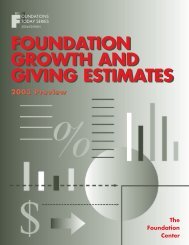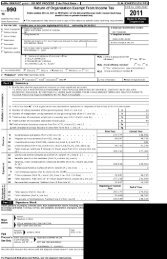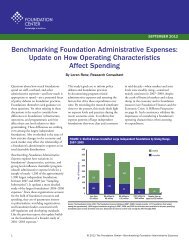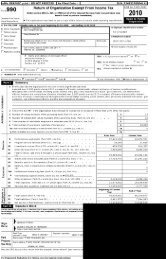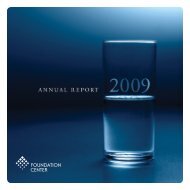Download Philanthropy Annual PDF - Foundation Center
Download Philanthropy Annual PDF - Foundation Center
Download Philanthropy Annual PDF - Foundation Center
You also want an ePaper? Increase the reach of your titles
YUMPU automatically turns print PDFs into web optimized ePapers that Google loves.
C o m m e n t a r y & O p i n i o n<br />
average of 30 percent a year, compared<br />
to the average nonprofit growth rate<br />
of 5 percent a year. The social innovators<br />
who participated in the program<br />
said that the payoff in both improved<br />
operations and grateful investors was<br />
worth it.<br />
Designing a solid performance<br />
measurement system is less daunting<br />
than it might seem; you don’t have to<br />
gather an enormous amount of data.<br />
While there’s much discussion today<br />
about standardized indices, you can go<br />
a long way right now in creating a program<br />
that is both customized to your<br />
needs and easily understood by funders.<br />
These are the key things to address:<br />
u Review your mission. Make sure it’s<br />
specific enough and that all your programs<br />
and services link to it.<br />
u Select measurement indicators tied to<br />
your organization’s strategic plan and<br />
internal goals.<br />
u Include indicators not only for organizational<br />
health and program performance,<br />
but also for social and economic performance<br />
that give a real sense of your<br />
organization’s outcomes and progress in<br />
meeting its vision. Example: If your goal<br />
is to get high school students into college,<br />
you’ll want to track what percent of your<br />
program’s graduates enroll in college<br />
because of your work, not just the number<br />
of students you counseled. Select indicators<br />
that will drive effective behaviors.<br />
u If you’re just starting out on this, keep<br />
it simple; don’t get overwhelmed. Focus<br />
on what’s most helpful to better understand<br />
your progress in carrying out your<br />
mission. You can refine later.<br />
u Employ a variety of measurement tools,<br />
including spreadsheets and intake forms,<br />
interviews, observations, and surveys. (You<br />
might want to hire an evaluation expert to<br />
help you create a meaningful survey.)<br />
It is important, of course, that your<br />
measurement system allows room for<br />
experimentation; that’s the essence of<br />
innovation. Especially in the early years,<br />
you need to have some time and freedom<br />
to test what works.<br />
u The best part: Be prepared for some<br />
terrific learning opportunities for your<br />
efforts. Your data will help you more<br />
clearly see opportunities for ongoing<br />
improvement and modifications in your<br />
programs, ultimately leading to more<br />
success and an impressive “report card”<br />
that will help you keep current donors<br />
and impress potential ones.<br />
If you put a stake in the ground in<br />
impact measurement and organizational<br />
metrics, you’ll be one of those who<br />
is rewarded with resources. And those<br />
with resources to give will continue<br />
to invest, because you’ve clearly shown<br />
both them and yourself how you’re<br />
meeting your goals and developing<br />
enduring solutions to social problems.<br />
Andrew Wolk is CEO and founder of Root<br />
Cause, a nonprofit organization headquartered<br />
in Cambridge, Massachusetts, that advises<br />
innovative nonprofits and educates social<br />
impact investors. He is also a lecturer in social<br />
entrepreneurship at Harvard University and<br />
MIT, and the co-author of Building a<br />
Performance Measurement System: Using<br />
Data to Accelerate Social Impact.<br />
Social Media Can Open Door to<br />
<strong>Philanthropy</strong>’s Future<br />
By Larry Blumenthal, Former Director, Social Media Strategy,<br />
Robert Wood Johnson <strong>Foundation</strong><br />
In retrospect, I’m not sure I would try this exercise again.<br />
A few months back, I began a workshop for staff from a variety of<br />
foundations by asking them to shout out all of their whiny, cry-baby<br />
excuses for not getting involved in social media. The excuses flew at<br />
me fast and furious, like so many tranquilizer darts. I don’t have time.<br />
It’s too much work. We don’t have the resources. Can’t figure out the<br />
return on investment. Senior staff don’t see the value. We’re afraid of<br />
losing control. What if people criticize us? My shoes are too tight.<br />
I<br />
was going down like one of those tagged bears on<br />
Animal Planet (or my chunky Uncle Bernie after<br />
eating both drumsticks on Thanksgiving).<br />
Then I heard the excuse that got my blood pumping<br />
again: “Social media doesn’t seem relevant to my work.”<br />
There it was. All of this talk about Twitter, Facebook,<br />
YouTube. It all feels like so much noise. Why should I<br />
care that someone with a wolverine tattoo on his neck<br />
and a self-inflicted case of ADD is tweeting that he is<br />
stuck in line at Starbucks? What does that have to do<br />
with grantmaking? And does he really need more caffeine, anyway?<br />
I realized I had about 45 minutes to convince these people that social media is<br />
more than relevant to philanthropy. That it is core to our future. That social media<br />
can make us all better philanthropists. There I said it. Social media can make foundations<br />
more effective. I know that doesn’t go down easily, but here is an exercise:<br />
50 | <strong>Philanthropy</strong> <strong>Annual</strong> 2009





